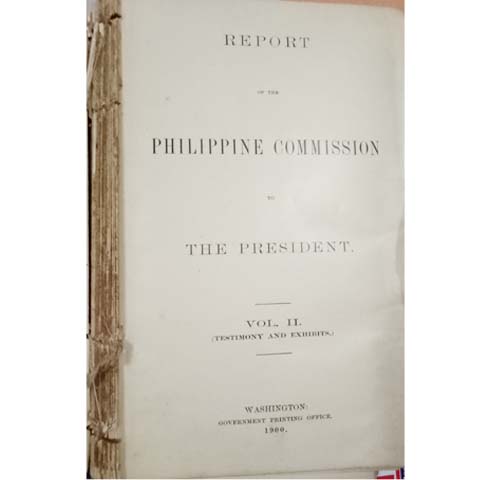When the Americans occupied the Philippines in 1898, they also encountered the Chinese problem. To know the situation of the Chinese in the Philippines and help it formulate policies toward the Chinese, the first Philippine Commission created by US President William McKinley conducted a series of hearings to which it invited resource persons to share information and viewpoints about the Chinese.
The commission’s volume II report in 1900 was mainly about the Chinese in the Philippines. It showed there were only two Chinese, A.R.M. Ongcakwe and Carlos Palanca, who were invited to appear before the commission. This was on June 30, 1899.
We reprint Ongcakwe’s testimony and highlight an important piece of information he provided:
Testimony of A.R.M. Ongcakwe
Manila, June 30, 1899
Present: Colonel Denby (in the Chair), Professor Worcester and Mr. MacArthur
A.R.M. Ongcakwe, in answer to questions propounded, stated as follows:
By Colonel Denby:
Q: State your name, age, residence and occupation.
A: A.R.M. Ongcakwe; residence, Manila; occupation, merchant
Q: How long have you lived here?
A: Twenty-two years.
Q: What business are you engaged in?
A: Export sugar business.
Q: You export sugar?
A: Yes, sir.
Q: And what else?
A: And import rice.
Q: And general import business from China?
A: Yes
Q: How many Chinese are here?
A: Only here in Manila?
Q: Well, say first in Manila.
A: About 25,000 men, I think.
Q: What business are they engaged in?
A: I cannot answer that. Mr. Palanca will be able to answer that better than I can.
Q: Don’t you know what business they do?
A: Yes, I know some.
Q: Tell us what you know.
A: In the import business, there are about 20 or 30 people engaged here.
Q: There are merchants and peddlers?
A: Yes, sir.
Q: There are laborers and coolies?
A: About 8,000 to 10,000 men are coolies.
Q: What kind of people are they, good people or bad people?
A: Good people. All coolies discharging and loading cargoes.
Q: Don’t the Filipinos discharge cargoes?
A: Yes, some Filipinos.
Q: They do hard work, do they, the Chinese?
A: Oh, yes.
Q: How many of them are in these islands – all the Philippine islands?
A: About 55,000 Chinese.
Q: Where are they?
A: In all the provinces and in Manila, 55,000 men.
Q: Do they do any agricultural work?
A: Yes, sir.
Q: What?
A: Gardening and sugar plantations and vegetable gardens.
Q: They work the hemp plantations too?
A: Yes, in Iloilo.
Q: How are they affected with regard to the United States of America? How are they toward the Americans, friendly or unfriendly?
A: Very friendly.
Q: Do they do any business with the United States?
A: Not at present, directly with the United States, no.
Q: What kind of citizens do they make – quiet, peacemaker, or not?
A: Very law abiding. All those that come here are law abiding and peaceful.
Q: How are they about paying their debt?
A: Excluding fire or loss from ships, they generally pay their debts.
Q: They pay their debts?
A: Yes, sir.
Q: How many Chinese do you think ought to be allowed to come here every year?
A: About 12,000.
Q: Twelve thousand a year?
A: They go back to China seven or eight thousand a year.
Q: Seven or eight thousand go back to China every year?
A: Yes, besides the head passengers.
Q: Do you think that business would require 12,000 here a year?
A: Oh, yes.
Q: Are you in favor of allowing the Chinese to come here or not?
A: We like very much to have the Chinese come here. There is want of Chinese labor steadily.
Q: Do you think it would be for the good of the island to let the Chinese come here?
A: If they had plenty of Chinese here they would do more business.
Q: If the Chinese were not here, wouldn’t the Filipinos do the work?
A: I don’t think that the Filipinos would work.
Q: Why not?
A: You see, if the Filipino, for instance, has two cents today, he does not want to work again tomorrow; he wants to spend that money. We Chinaman no; we work very hard.
We want to highlight Ongcakwe’s statement that there were about 8,000 to 10,000 Chinese laborers or coolies at the time who engaged in discharging and loading cargoes.
Considering the Chinese population then in Manila and the Philippines were 25,000 and 55,000, respectively, its 8,000 or 10,000 coolie component represented quite a significant proportion.
It means that during the late Spanish period, many Chinese in the Chinese community were laborers or coolies by occupation, contrary to the stereotype that most, if not all Chinese, were businessmen or even born merchants.
This important historical fact is often neglected, even in the academic circle. It needs to be highlighted and emphasized.
